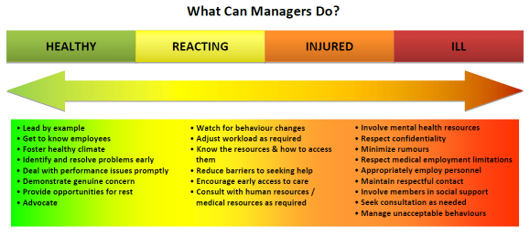Mental Health and the Workplace - Understanding Plus Action
 May is a much anticipated and welcomed month for New Englanders. At last, the discolored piles of snow have melted, and shovels and winter jackets are retired. April’s rain has given way to a colorful blooming ecosystem. Some people anticipate the end of homework battles, time spent outdoors socializing (while physically distanced), and warm weather activities they treasure. May, however, is not experienced in these ways by everyone. In fact, for many it can feel gloomy like an endless rainy January afternoon, or full of panic as when a tornado strikes. Perhaps you know one or two people who are experiencing life in these ways.
May is a much anticipated and welcomed month for New Englanders. At last, the discolored piles of snow have melted, and shovels and winter jackets are retired. April’s rain has given way to a colorful blooming ecosystem. Some people anticipate the end of homework battles, time spent outdoors socializing (while physically distanced), and warm weather activities they treasure. May, however, is not experienced in these ways by everyone. In fact, for many it can feel gloomy like an endless rainy January afternoon, or full of panic as when a tornado strikes. Perhaps you know one or two people who are experiencing life in these ways.
May is Mental Health Awareness Month and an opportunity to raise consciousness and advance the dialogue around mental health impacts, what to say to someone who is struggling, and how to promote help-seeking behavior. Let us consider how employers can support employees in distress by being observant, connecting with empathy, and guiding them to professional support and resources.
People come to their work with many identities (e.g., professionals, parents, partners, grandparents, caregivers, etc.) as well as their triumphs, stressors, and health conditions, including mental health conditions. Some employees have moderate or serious mental health problems that never become evident to supervisors. Others have difficulties that can manifest in their conduct, lapses in fulfilling work responsibilities, or absenteeism. Many factors influence this, including the type and frequency of mental health assistance they receive and the stressors in their lives.
It can be surprising to learn that many employees are working while struggling with their mental health. According to the National Institute of Mental Health, “nearly one in five U.S. adults lives with a mental illness (51.5 million in 2019). Mental illnesses include many different conditions that vary in degree of severity.”1 Countless others struggle with mental health challenges that may not qualify for a medical diagnosis. These difficulties can affect one’s level of optimism, confidence, self-worth, ability to see one’s strengths, energy, sense of reality, belief that life is worth living, use of coping skills, care for physical health, connection to others, ability to focus and problem solve, sense of belonging and purpose, and more.
Imagine if you were struggling in several of these areas while needing to accomplish tasks at home and achieve goals at your job, all while the pandemic caused you further strain or symptom exacerbation. The following are only some of the many challenges reported throughout the pandemic to licensed mental health providers in private practices, counseling centers, and Employee Assistance Programs.
- Grief – with a focus on their loved one dying alone compounded by the absence of communal mourning traditions
- Racial trauma following verbal and physical violence toward Black, Indigenous, and People of Color (e.g., fear of walking outside alone, anger, hopelessness, loss of motivation)
- Symptoms of anxiety and/or depression related to:
- Loss of pre-pandemic routines that calmed anxiety and helped people to cope
- Disconnection and isolation
- Unrelenting worry about getting COVID-19, becoming unable to care for a child and/or elderly parents, or dying
- Negative self-image - “underperforming” as a parent and/or as an employee; thoughts of “failing on all fronts”
- ADHD - work processes changed with remote offices, strategies for managing ADHD are not working or working less effectively.
These challenges illustrate how employees carry burdens that can compound a mental illness that predated March 2020. Much support is needed by employees, and it can begin when a manager acts on their observations with professionalism and compassion. The Government of Canada2 offers the following graphic on how managers can promote wellbeing across a continuum by remaining aware, looking and listening, fostering a supportive environment, and enabling employees to get help.
Pay Attention to The Signs
No one is expected to treat a colleague’s mental health problem, but it is important to know when professional support might be needed. Stay mindful of the following behaviors in your team members:
- Fatigued, tearful, withdrawn, down
- Poor hygiene and overall appearance
- Abnormally jumpy, restless, or “wired”
- Apathetic or having substandard work (trouble completing tasks, meeting due dates, etc.)
- Increased agitation, argumentative, outbursts of anger
- Frequent absences
- Extreme/exaggerated sense of well-being & confidence (euphoria) and talking faster than is normal for that employee
- Slurred speech, smelling of alcohol, bloodshot eyes, sleeping at work
- In the absence of a terminal illness, giving away belongings or discussing not being around
If this list evokes a sigh, rest assured that there is also hope! Managers can be incredibly effective at ushering employees toward the help they need and ultimately a return to former levels of health and productivity, contribution, accountability, and creativity.
When a manager sees signs, what’s next?
Due to regular contact with staff, managers are in an excellent position to guide employees to appropriate support. Many, however, worry about saying the wrong thing or being thought of as prying. These worries can be remedied by seeking consultation and guidance from Human Resources and the mental health professionals at their company’s Employee Assistance Program (EAP). Regardless of a manager’s comfort level or knowledge of mental health, coaching and guidance is available.
Here are two examples of soft start-up lines for a manager when approaching their colleague:
State observations clearly and with empathy.
“I see that you’ve missed two deadlines and I’d like to discuss that. We can brainstorm how I can assist you to stay on track. I also noticed you crying the other day and I’m concerned for you. You don’t have to talk specifics, but there are confidential resources available to help and I’d like to share those.”
“Based upon what you said in staff meeting, it sounds like you have an incredible degree of stress at home. I can’t know what it’s like for you, but I can listen. And we have lots of resources at the EAP.”
The manager should listen closely to the response and proceed from there by suggesting appropriate resources (EAP, health insurance benefit, Occupational Health, Wellness Coach, etc.). If the manager has ever contacted an EAP or another support service, this is a great opportunity to role model the courage of asking for help. If inclined, the Manager can share in a general way how they experienced the service. An EAP makes recommendations and is available at a moment’s notice to provide phone or video counseling to an employee. If a group of managers or other leaders would benefit from an EAP overview, organizations should not hesitate to request a presentation on the process of referring, the types of referrals, access points, confidentiality, and the array of benefits. EAPs are happy to share this.
We know that most employees are relieved and appreciative when a colleague expresses care and concern. Regardless of how an employee responds in the moment, mental health professionals assure us that a difference is made! In fact, even if an employee does not follow through to obtain help, their manager increased the probability that they will reach out in the future.
And why is this true? Because it is often a turning point to hear that one’s work product and team contributions are valued and missed, and that changes have been noticed. When an attentive supervisor reflects compassionately to an employee what they hear and see, they effectively hold up a mirror to their colleague’s state of mind while also bringing them out of isolation. Also, when we broach a topic that touches upon our shared vulnerabilities and human experiences, two things happen: 1) we create connection – the foundation of resilience; and 2) the stigma of having emotional struggles loses its power.
A Checklist for Employers:
- Observe your employees, tune-in and follow your instincts.
- Utilize resources / seek consultation.
- Be brave and speak with the colleague about whom you are concerned.
- Be empathic. Listen closely. Breathe.
- Refer them to your EAP or other support offering. Seek consultation if unsure of where to start.
- Document your conversation and inform Human Resources of any concerns.
- Check-in periodically with your colleague.
- Take good care of yourself.
1https://www.nimh.nih.gov/health/statistics/mental-illness.shtml
Andrea Kramer is a Senior EAP Consultant at KGA. She can be reached at: [email protected].


